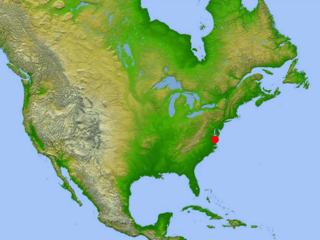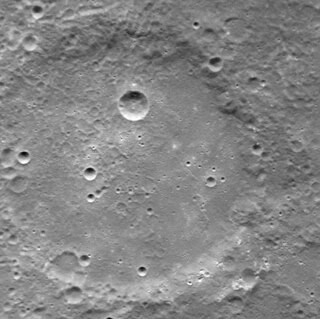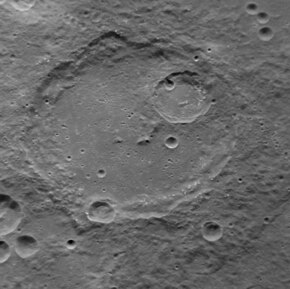
The Chesapeake Bay impact crater is a buried impact crater, located beneath the mouth of Chesapeake Bay, United States. It was formed by a bolide that struck the eastern shore of North America about 35.5 ± 0.3 million years ago, in the late Eocene epoch. It is one of the best-preserved "wet-target" impact craters in the world.

Ångström is a small lunar impact crater located on the border between Oceanus Procellarum to the west and Mare Imbrium to the east. To the south is a formation of mountains rising out of the mare named the Montes Harbinger. To the east are some wrinkle ridges named the Dorsum Bucher and Dorsa Argand. This crater is bowl-shaped, with a circular rim and inner walls that slope down to the small central floor. It has a higher albedo than the surrounding maria. The crater halo is radar dark, indicating a lack of larger blocks among the fine ejecta.

Anders is a worn lunar impact crater that is located in the southern hemisphere on the far side of the Moon. It lies just to the southeast of the outer rim of the huge walled basin named Apollo. To the south-southeast is the crater Leavitt.

The far side of the Moon is the lunar hemisphere that always faces away from Earth, opposite to the near side, because of synchronous rotation in the Moon's orbit. Compared to the near side, the far side's terrain is rugged, with a multitude of impact craters and relatively few flat and dark lunar maria ("seas"), giving it an appearance closer to other barren places in the Solar System such as Mercury and Callisto. It has one of the largest craters in the Solar System, the South Pole–Aitken basin. The hemisphere has sometimes been called the "dark side of the Moon", where "dark" means "unknown" instead of "lacking sunlight" – each side of the Moon experiences two weeks of sunlight while the opposite side experiences two weeks of night.

Apollo, also called the Apollo basin, is an enormous impact crater located in the southern hemisphere on the far side of the Moon. This formation dwarfs the large crater Oppenheimer that is located next to the western rim. The crater Barringer lies across the northern wall. To the southeast is the crater Anders, and Kleymenov is just to the east of the rim.

Borman is a lunar impact crater that is located in the southern hemisphere on the far side of the Moon. It lies across the southeast section of the mountainous inner ring, within the walled basin named Apollo.

Celsius is a small lunar impact crater that is located in the rugged terrain in the southern hemisphere on the Moon's near side. It is named after Swedish astronomer, physicist and mathematician Anders Celsius. It lies less than one crater diameter to the south-southwest of the crater Zagut, and due north of Büsching.

Pasteur is a large lunar impact crater, approximately 233 kilometers in diameter, belonging to the category termed a walled plain. It was named after French chemist and microbiologist Louis Pasteur. It lies on the far side of the Moon as seen from the Earth, just beyond the eastern limb. The vicinity of this crater is occasionally brought into view from Earth due to librations, although not much detail can be seen.

Lovell is a small lunar impact crater that lies across the eastern edge of the walled plain Apollo, on the far side of the Moon. It has a somewhat irregular shape, with outward bulges to the north and west. The rim is sharp-edged, with some slight wear along the northwestern bend. The featureless inner walls slope directly down to the uneven interior floor.
Celsius is a temperature scale.

The Lac Wiyâshâkimî, also called the Clearwater Lakes in English and Allait Qasigialingat by the Inuit, are a pair of annular lakes and possible impact craters on the Canadian Shield in Quebec, Canada, near Hudson Bay.

Earthrise is a photograph of Earth and part of the Moon's surface that was taken from lunar orbit by astronaut William Anders on December 24, 1968, during the Apollo 8 mission. Nature photographer Galen Rowell described it as "the most influential environmental photograph ever taken".
The angstrom is a unit of length equal to 0.1 nanometre, also spelled ångström.

Africanus Horton is a crater on Mercury. It was named by the IAU in 1976, after Africanus Horton, a Creole African nationalist writer and an esteemed medical surgeon in the British Army from Freetown, Sierra Leone.

Anders Jonas Ångström was a Swedish physicist and one of the founders of the science of spectroscopy.
Andal was a poet-saint of South India.

The Ordovician meteor event was a dramatic increase in the rate at which L chondrite meteorites fell to Earth during the Middle Ordovician period, about 467.5±0.28 million years ago. This is indicated by abundant fossil L chondrite meteorites in a quarry in Sweden and enhanced concentrations of ordinary chondritic chromite grains in sedimentary rocks from this time. This temporary increase in the impact rate was most likely caused by the destruction of the L chondrite parent body 468 ± 0.3 million years ago having scattered fragments into Earth-crossing orbits, a chronology which is also supported by shock ages in numerous L chondrite meteorites that fall to Earth today. It has been speculated that this influx contributed to, or possibly even instigated, the Great Ordovician Biodiversification Event, although this has been questioned.

Anders' Earthrise is a lunar impact crater that is located on the southern hemisphere on the far side of the Moon. It is visible in the foreground of the famous Earthrise photograph (AS08-14-2383) taken by astronaut William Anders on the Apollo 8 mission to the Moon in 1968. The crater's name was approved by the IAU on 5 October 2018. The crater 8 Homeward, also visible in the Earthrise photograph, was named at the same time.

8 Homeward is a lunar impact crater that is located on the southern hemisphere on the far side of the Moon. It is visible in the left horizon of the famous Earthrise photograph (AS08-14-2383) taken by astronaut William Anders on the Apollo 8 mission to the Moon in 1968. The crater's name was approved by the IAU on 5 October 2018. The crater Anders' Earthrise, also visible in the Earthrise photograph, was named at the same time.














